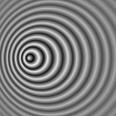The Doppler Effect
Named after the person who first proposed the idea, the Doppler effect is best described as follows. The intensity of the sound increases as an object approaches and decreases as it goes away. Christian Doppler first wrote in 1842, about it when describing why some stars were colored red ( red shift ) and some stars appeared blue ( blue shift ). This was his most notable work published as "Über das farbige Licht der Doppelsterne und einiger anderer Gestirne des Himmels" Also known as the Doppler shift, the theory was tested in 1845 by Buys Ballot when he confirmed that the pitch of an object was higher than its emitted frequency when it approached and lower as it recedes. Doppler was born in Salzburg, Austria November 29, 1803. He was a brilliant mathematician and physicist. Also see related topics
What is ultrasound
and
How it works

The Doppler effect is also described as when a stone is thrown into a pond and the waves coming from the water being disturbed creates concentric circles coming from the spot that it hit. The frequency of the waves is constant, but if you were traveling toward the spot of impact. You would see the waves as coming at you faster on the front side of the oncoming waves, because the waves on the other side of the impact zone are moving away from you.

Another way to explain it is when a car is blowing its horn as it comes at you, it has a higher pitch than the actual sound of the horn, then as it goes by, the pitch becomes lower than the actual sound because the car is receding and the waves take longer to get to your ears. All the while, the horn has the same frequency and is constant. Christian Doppler died March 17, 1853. If you want to know about a practical application of the
Doppler effect, check 4 D ultrasound.
Want to make your computer make money for you? Computers never sleep.
Take the video tour of SBI
Genesis Ultrasound machine Home Page
Sources:
wikipedia
Daniel A. Russell, Kettering University
For an animated graphic of this, go tohttp://www.walter-fendt.de/ph11e/dopplereff.htm/




